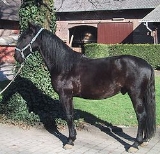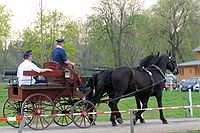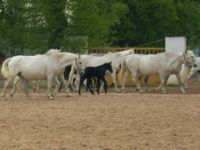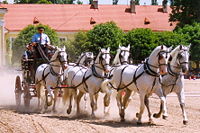
Kladruber
Encyclopedia
The Kladruber is the oldest Czech horse breed
, and today is considered very rare. The main breeding centre is in National stud farm Kladruby nad Labem
in the Czech republic
where Kladrubers have been bred for more than 400 years, being now one of the world's oldest horse breeds. Kladrubers have always been bred to be a galakarosier - a heavy type of carriage horse for the court of the House of Habsburg.
national stud, the Kladruber breed is almost 400 years old, yet is remarkably rare (492 mares as of January, 2011). Kladruby stud was founded in 1579 by Rudolf II as an Imperial stud, at the Perlstein stables. The breed was based on imported Spanish (such as the Andalusian
) and Italian horses, crossed with Neapolitan
, Danish, Holstein, Irish, and Oldenburg
blood, in addition to the heavy Czech breeds. The animal was first developed to be a galakarosier; a heavy type of carriage horse used to pull the imperial coach, usually in a four- or six-in-hand, at ceremonies and funerals. It originally came in a variety of colors, including palomino
and appaloosa
, although today the breed is strictly gray
or black
, due to a breeding program requiring 18 "white" (i.e. fully mature grays) and 18 black stallions for various ceremonies of the court.
 The stud was evacuated during the Seven Years' War
The stud was evacuated during the Seven Years' War
to Kopcany, Slovakia
and Enyed, Hungary
. Due to a fire in 1757, the earliest 200 years of breeding records were lost, and the stud was dissolved before the remaining breeding stock was brought back to the a new stud in Kladruby. The surviving records show a particular influence by several stallions on the herd of gray Kladrubers:
 The herd of black Kladrubers had two particular influential stallions, Sacramoso (born 1799) and Napoleone (born 1845), and was regenerated in Slatinany. The black and white Kladrubers have several differences due to their breeding. The white is finer, more Thoroughbred
The herd of black Kladrubers had two particular influential stallions, Sacramoso (born 1799) and Napoleone (born 1845), and was regenerated in Slatinany. The black and white Kladrubers have several differences due to their breeding. The white is finer, more Thoroughbred
ish in type, and usually taller than the black. The black has more Neapolitan blood, and thus is heavier, has a shorter croup, a different head and neck, and a more "Nordic" look to it.
Pepoli's bloodlines are still bred at the Kladruby Stud, but the herd of black horses sired by Sacromoso and Nepoleone was destroyed in the 1930s, after many of the animals were sold for meat. Despite the decimated herd, a few horses were saved and efforts have been made by breeders to re-establish their bloodlines at a new stud in Slatinany, at The Research Institute for Horse Breeding.
 Modern Kladrubers are usually gray
Modern Kladrubers are usually gray
. Many stand between 16.2 and 17 hands high 66 to 68 in (167.6 to 172.7 cm) and primarily used in harness
. They are suitable for light draft and agriculture, and can be seen at the international levels in the sport of combined driving
. This FEI
sport makes good use of the Kladruber's calm nature, endurance, and relative speed. The Kladruber is also occasionally crossbred with lighter breeds to produce a more suitable riding horse, usually for dressage
.
Due to their small gene pool
and long history of selective breeding, Kladruber type is well "set" and they possess recognizable breed characteristics. Many of these characteristics, such as a prominent Roman or convex facial profile, have been retained from their Baroque
ancestors. While the relatively upright shoulder, pasterns and hooves, long back, and short croup are not desirable in a riding horse, these qualities allow high-stepping gaits in a driving horse. The high-set, powerful and well-arched neck of the Kladruber was a trademark feature of their Spanish-Neapolitan
ancestors, and not only contributes to their appearance in harness. A horse of substance, the Kladruber possesses a deep, broad chest and sound legs with large joints and hooves. Their legs are unfeathered, though the mane and tail are thick and flowing, and the features are lean rather than fleshy. All gaits, though most especially the trot, should have high action and elasticity with a clear cadence.
Horse breed
Horse breed is a broad term with no clear consensus as to definition, but most commonly refers to selectively bred populations of domesticated horses, often with pedigrees recorded in a breed registry. However, the term is sometimes used in a very broad sense to define landrace animals, or...
, and today is considered very rare. The main breeding centre is in National stud farm Kladruby nad Labem
Kladruby nad Labem
Kladruby nad Labem is a village and municipality in the Pardubice Region of the Czech Republic, located abot 6 km northwest of Přelouč or 22 km west of Pardubice...
in the Czech republic
Czech Republic
The Czech Republic is a landlocked country in Central Europe. The country is bordered by Poland to the northeast, Slovakia to the east, Austria to the south, and Germany to the west and northwest....
where Kladrubers have been bred for more than 400 years, being now one of the world's oldest horse breeds. Kladrubers have always been bred to be a galakarosier - a heavy type of carriage horse for the court of the House of Habsburg.
Timeline of Imperial stud farm Kladruby nad Labem
- 1491 Pernstein family has bought the Pardubice estate, later including Kladruby park
- 1560 Maxmilian II. (emperor since 1563) was given the Pardubice estate with Kladruby park as a gift from the Czech estates
- 1562 Maximilian II, Holy Roman EmperorMaximilian II, Holy Roman EmperorMaximilian II was king of Bohemia and king of the Romans from 1562, king of Hungary and Croatia from 1563, emperor of the Holy Roman Empire of the German Nation from 1564 until his death...
has founded an old-Spanish horse stud farm in Kladruby
- 1579 Rudolf II, Holy Roman EmperorRudolf II, Holy Roman EmperorRudolf II was Holy Roman Emperor , King of Hungary and Croatia , King of Bohemia and Archduke of Austria...
gave the stud farm an Imperial Court Stud Farm statute
- 1757 Stud farm (with studbook documents) has burned down
- 1770 Joseph II, Holy Roman EmperorJoseph II, Holy Roman EmperorJoseph II was Holy Roman Emperor from 1765 to 1790 and ruler of the Habsburg lands from 1780 to 1790. He was the eldest son of Empress Maria Theresa and her husband, Francis I...
has rebuilt the stud farm
- 1764 born Pepoli, founding stallion of the gray variety of Kladrubers
- 1787 born Generale, gray stallion
- 1797 born Generalissimus, gray stallion
- 1800 born Sacramoso, black stallion
- 1844 new Empire (style)Empire (style)The Empire style, , sometimes considered the second phase of Neoclassicism, is an early-19th-century design movement in architecture, furniture, other decorative arts, and the visual arts followed in Europe and America until around 1830, although in the U. S. it continued in popularity in...
stables built
- 1918 the stud farm managed by the newly established CzechoslovakiaCzechoslovakiaCzechoslovakia or Czecho-Slovakia was a sovereign state in Central Europe which existed from October 1918, when it declared its independence from the Austro-Hungarian Empire, until 1992...
- 1922 Napoleone bloodline extinct
- 1995 Kladruber breed was designated a Czech Historic Landmark
- 2002 Kladruby stud farm and the basic herd of gray Kladrubers was designated a Czech National Historic Landmark
- 2005 Kladrubers serve on ceremonial occasions at Royal Court of SwedenRoyal Court of SwedenThe Royal Court of Sweden is the official name for the organisation that supports the Monarch of Sweden, and the Royal House...
and are used by mounted police of Sweden as well
History
Bred in Kladruby nad LabemKladruby nad Labem
Kladruby nad Labem is a village and municipality in the Pardubice Region of the Czech Republic, located abot 6 km northwest of Přelouč or 22 km west of Pardubice...
national stud, the Kladruber breed is almost 400 years old, yet is remarkably rare (492 mares as of January, 2011). Kladruby stud was founded in 1579 by Rudolf II as an Imperial stud, at the Perlstein stables. The breed was based on imported Spanish (such as the Andalusian
Andalusian horse
The Andalusian, also known as the Pure Spanish Horse or PRE , is a horse breed developed in the Iberian Peninsula. Its ancestors have been present on the Iberian Peninsula for thousands of years. The Andalusian has been recognized as an individual breed since the 15th century, and its conformation...
) and Italian horses, crossed with Neapolitan
Neapolitan horse
The Neapolitan Horse, , Neapolitano or Napolitano, is a horse breed that originated in the plains between Naples and Caserta, in the Campania region of Italy, but which may have been bred throughout the Kingdom of Naples. The Neapolitan horse was frequently mentioned in literature from the 16th to...
, Danish, Holstein, Irish, and Oldenburg
Oldenburg (horse)
The Oldenburg is a warmblood horse from the north-western corner of Lower Saxony, what was formerly the Grand Duchy of Oldenburg. The breed was built on a mare base of all-purpose farm and carriage horses, today called the Alt-Oldenburger...
blood, in addition to the heavy Czech breeds. The animal was first developed to be a galakarosier; a heavy type of carriage horse used to pull the imperial coach, usually in a four- or six-in-hand, at ceremonies and funerals. It originally came in a variety of colors, including palomino
Palomino
Palomino is a coat color in horses, consisting of a gold coat and white mane and tail. Genetically, the palomino color is created by a single allele of a dilution gene called the cream gene working on a "red" base coat...
and appaloosa
Appaloosa
The Appaloosa is a horse breed best known for its colorful leopard-spotted coat pattern. There is a wide range of body types within the breed, stemming from the influence of multiple breeds of horses throughout its history. Each horse's color pattern is genetically the result of various spotting...
, although today the breed is strictly gray
Gray (horse)
Gray or grey is a coat color of horses characterized by progressive silvering of the colored hairs of the coat. Most gray horses have black skin and dark eyes; unlike many depigmentation genes, gray does not affect skin or eye color Their adult hair coat is white, dappled, or white intermingled...
or black
Black (horse)
Black is a hair coat color of horses in which the entire hair coat is black. Black is a relatively uncommon coat color, and novices frequently mistake dark chestnuts or bays for black. However, some breeds of horses, such as the Friesian horse, Murgese and Ariegeois are almost exclusively black...
, due to a breeding program requiring 18 "white" (i.e. fully mature grays) and 18 black stallions for various ceremonies of the court.

Seven Years' War
The Seven Years' War was a global military war between 1756 and 1763, involving most of the great powers of the time and affecting Europe, North America, Central America, the West African coast, India, and the Philippines...
to Kopcany, Slovakia
Slovakia
The Slovak Republic is a landlocked state in Central Europe. It has a population of over five million and an area of about . Slovakia is bordered by the Czech Republic and Austria to the west, Poland to the north, Ukraine to the east and Hungary to the south...
and Enyed, Hungary
Hungary
Hungary , officially the Republic of Hungary , is a landlocked country in Central Europe. It is situated in the Carpathian Basin and is bordered by Slovakia to the north, Ukraine and Romania to the east, Serbia and Croatia to the south, Slovenia to the southwest and Austria to the west. The...
. Due to a fire in 1757, the earliest 200 years of breeding records were lost, and the stud was dissolved before the remaining breeding stock was brought back to the a new stud in Kladruby. The surviving records show a particular influence by several stallions on the herd of gray Kladrubers:
- Pepoli: a gray who sired the colt Generale in Kopcany in 1787. Generale is thought to be the progenitor of all gray Kladrubers today, and he produced the son Generalissimus (1797) who produced a separate lineage.
- Maestoso (1773) and Favory (1779): born in Kladruby, became two of the six founding Lipizzaner stallion lineages. Favory returned to Kladruby after WWII, to add new blood to the decimated herd.
- Barzoi and Legion: Orlov TrotterOrlov TrotterThe Orlov Trotter is a horse breed with a hereditary fast trot, noted for its outstanding speed and stamina. It is the most famous Russian horse. The breed was developed in Russia in the late 18th century by Count Alexei Orlov at his Khrenovskoy Stud farm near the town of Bobrov...
s added new blood between WWI and WWII. - Rudolfo: A Lusitano from Portugal, added new blood after WWII.

Thoroughbred
The Thoroughbred is a horse breed best known for its use in horse racing. Although the word thoroughbred is sometimes used to refer to any breed of purebred horse, it technically refers only to the Thoroughbred breed...
ish in type, and usually taller than the black. The black has more Neapolitan blood, and thus is heavier, has a shorter croup, a different head and neck, and a more "Nordic" look to it.
Pepoli's bloodlines are still bred at the Kladruby Stud, but the herd of black horses sired by Sacromoso and Nepoleone was destroyed in the 1930s, after many of the animals were sold for meat. Despite the decimated herd, a few horses were saved and efforts have been made by breeders to re-establish their bloodlines at a new stud in Slatinany, at The Research Institute for Horse Breeding.
Breed characteristics

Gray (horse)
Gray or grey is a coat color of horses characterized by progressive silvering of the colored hairs of the coat. Most gray horses have black skin and dark eyes; unlike many depigmentation genes, gray does not affect skin or eye color Their adult hair coat is white, dappled, or white intermingled...
. Many stand between 16.2 and 17 hands high 66 to 68 in (167.6 to 172.7 cm) and primarily used in harness
Driving (horse)
Driving, when applied to horses, ponies, mules, or donkeys, is a broad term for hitching equines to a wagon, carriage, cart, sleigh, or other horse-drawn vehicle by means of a harness and working them in this way...
. They are suitable for light draft and agriculture, and can be seen at the international levels in the sport of combined driving
Combined driving
Combined driving also known as Horse Driving Trials is an equestrian sport involving carriage driving. In this discipline the driver sits on a vehicle drawn by a single horse, a pair or a team of four. The sport has three phases: Dressage, Cross-country Marathon and Obstacle Cone Driving and is...
. This FEI
International Federation for Equestrian Sports
The Fédération Équestre Internationale or in English, the International Federation for Equestrian Sports, is the international governing body of equestrian sports. It recognizes ten international disciplines...
sport makes good use of the Kladruber's calm nature, endurance, and relative speed. The Kladruber is also occasionally crossbred with lighter breeds to produce a more suitable riding horse, usually for dressage
Dressage
Dressage is a competitive equestrian sport, defined by the International Equestrian Federation as "the highest expression of horse training." Competitions are held at all levels from amateur to the World Equestrian Games...
.
Due to their small gene pool
Gene pool
In population genetics, a gene pool is the complete set of unique alleles in a species or population.- Description :A large gene pool indicates extensive genetic diversity, which is associated with robust populations that can survive bouts of intense selection...
and long history of selective breeding, Kladruber type is well "set" and they possess recognizable breed characteristics. Many of these characteristics, such as a prominent Roman or convex facial profile, have been retained from their Baroque
Baroque horse
The Baroque horse is a term used to generally describe the type of agile but strong-bodied descendants of horses in the Middle Ages such as the destrier. Specific ancestors of this type include the Neapolitan horse, and the Iberian horse of Barb ancestry known in the Middle Ages as the Spanish...
ancestors. While the relatively upright shoulder, pasterns and hooves, long back, and short croup are not desirable in a riding horse, these qualities allow high-stepping gaits in a driving horse. The high-set, powerful and well-arched neck of the Kladruber was a trademark feature of their Spanish-Neapolitan
Baroque horse
The Baroque horse is a term used to generally describe the type of agile but strong-bodied descendants of horses in the Middle Ages such as the destrier. Specific ancestors of this type include the Neapolitan horse, and the Iberian horse of Barb ancestry known in the Middle Ages as the Spanish...
ancestors, and not only contributes to their appearance in harness. A horse of substance, the Kladruber possesses a deep, broad chest and sound legs with large joints and hooves. Their legs are unfeathered, though the mane and tail are thick and flowing, and the features are lean rather than fleshy. All gaits, though most especially the trot, should have high action and elasticity with a clear cadence.

